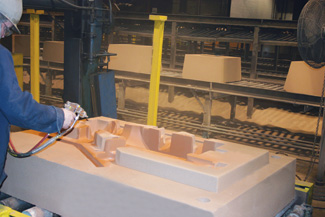Sand casting as a technology has been around for millennia and is selected as a preferred method to produce shaped parts that weigh less than a pound, to very large parts. The process is versatile and cost effective, even for low volume runs because of tooling cost. Nearly any part configuration that can be made using another casting process can be reduced to a pattern and created as a sand casting.
The MetalTek Sand Casting Process:

In Sand Casting, a pattern of the desired finished part including the metal delivery system (gates and risers) is constructed out of hardwood, urethane, metal or foam. Sand containing bonding material to retain its shape is packed around the pattern. The pattern is removed from the bonded sand, leaving a cavity in the mold that is in the shape of the part. Molten metal is poured into the cavity and the metal solidifies. The sand is removed though a shakeout process. Other cast attachments, including the metal delivery system, are trimmed leaving the desired part.
Internal passageways, including intricate structures, can be included in the sand castings by adding cores during the molding process. This makes sand casting a popular selection for pump and valve applications. Sand castings would typically be at least partially machined before use.
There are many advantages and disadvantages of the sand casting process:
Advantages
- Nearly Any Alloy
- Low Tooling Costs
- Versatility of Size, Weight, and Shape
- Any Quality
- Timing
Disadvantages
- Lower Dimensional Accuracy
- Pattern Maintenance
- Surface Finish
To learn more about the advantages and disadvantages of the sand casting process click here.
As an alternative to packing sand around the pattern, many customers take advantage of MetalTek’s Patternless Molding technology. Using this technology, a reverse of the casting is machined from sand to create the mold, rather than forming sand around a pattern. Production then proceeds normally. Timing is much quicker, design changes are easy, and hard patterns need not be stored or maintained.
MetalTek pours 100’s of ferrous and non-ferrous alloys:
- Up to 15 ft. / 4.6m linear, and large pit mold capacity
- Weights to 18,000 lbs. / 8,165 kg. ship weight
Sand casting – When to use it & Example Applications:
- Shaped or non-symmetrical parts
- Large parts
- Components with internal structures
- More liberal tolerances
Sand castings at MetalTek are produced at Carondelet.